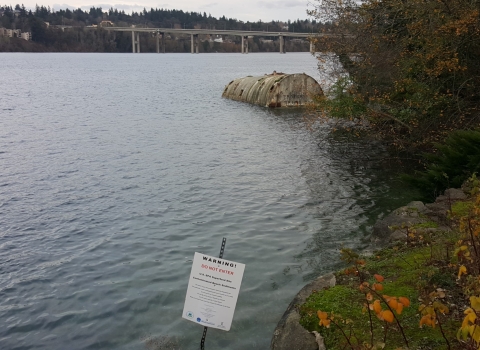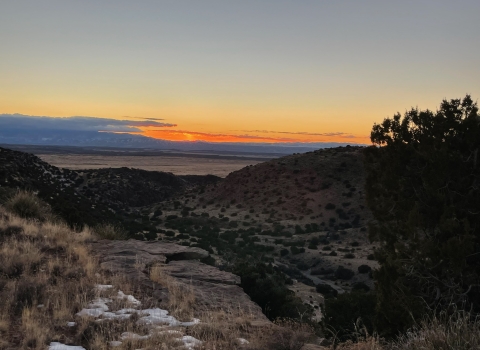September 26, 2023
Contact: Dan Chapman, daniel_chapman@fws.gov, 404-245-7211
U.S. Fish and Wildlife Service seeks public input on proposed Everglades to Gulf Conservation Area
The U.S. Fish and Wildlife Service is seeking public review and comment on a draft proposal establishing the Everglades to Gulf Conservation Area in southwest Florida. The proposed area abuts the Everglades Headwaters National Wildlife Refuge and Conservation Area and spans 12 counties west of Lake Okeechobee from Lakeland to Naples, including the watersheds of the Peace River, Myakka River, Fisheating Creek and Caloosahatchee River. The 30-day review and comment period will begin today and will include forthcoming public meetings where the Service will present and seek input on the proposed conservation area conservation area
A conservation area or wildlife management area is a type of national wildlife refuge that consists primarily or entirely of conservation easements on private lands. These conservation easements support private landowner efforts to protect important habitat for fish and wildlife. There are 15 conservation areas and nine wildlife management areas in the National Wildlife Refuge System.
Learn more about conservation area .
The proposal is informed by extensive public engagement that included more than 30 informational discussions with representatives from over 70 local, state, federal, tribal, non-governmental agencies and private landowners; seven public scoping meetings; a 35-day public scoping period; and the consideration of approximately 2,600 public comments, which were widely supportive. The resulting draft Land Protection Plan, Environmental Assessment and Conceptual Management Plan identify the vision, goals, objectives, acquisition boundary and conceptual management for the proposed Everglades to Gulf Conservation Area (previously referred to as the Southwest Florida Fish and Wildlife Conservation Area). The Conservation Area, if approved, would weave together public and private land protection opportunities similar to the partnership approach implemented at the Everglades Headwaters National Wildlife Refuge and Conservation Area over a decade ago.
“Recognizing the generations of responsible stewardship within this working rural landscape, this proposal seeks to secure a legacy of conservation lands for future generations to enjoy,” said Kathy Burchett, Refuge Supervisor for Florida and the Caribbean. “The proposed Everglades to Gulf Conservation Area would allow the Service to engage with partners and local landowners to preserve wildlife corridors and working lands with rich cultural history and traditions for the benefit of all people.”
The proposal identifies a four-million-acre Conservation Area in which the Service would pursue less-than-fee-title ( conservation easement conservation easement
A conservation easement is a voluntary legal agreement between a landowner and a government agency or qualified conservation organization that restricts the type and amount of development that may take place on a property in the future. Conservation easements aim to protect habitat for birds, fish and other wildlife by limiting residential, industrial or commercial development. Contracts may prohibit alteration of the natural topography, conversion of native grassland to cropland, drainage of wetland and establishment of game farms. Easement land remains in private ownership.
Learn more about conservation easement ) or fee-title acquisitions from willing sellers only. Conservation easements would provide landowners the opportunity to maintain working lands in their current configuration with no further subdivision or development. The Service could acquire up to 10% of the Conservation Area, or 400,000 acres, in fee-title acquisitions where wildlife-dependent recreation opportunities such as hunting, fishing, wildlife observation, photography, environmental education and interpretation, and opportunities for cultural, traditional and medicinal uses would be available.
The proposed Everglades to Gulf Conservation Area would protect species and improve their resiliency in the face of climate change climate change
Climate change includes both global warming driven by human-induced emissions of greenhouse gases and the resulting large-scale shifts in weather patterns. Though there have been previous periods of climatic change, since the mid-20th century humans have had an unprecedented impact on Earth's climate system and caused change on a global scale.
Learn more about climate change and extreme development pressures. Protection and management actions would also support Florida’s family farms and ranches, improve water quality, quantity, and water storage within the Greater Everglades and watersheds entering Charlotte Harbor.
This area is home to many rare and endemic plants and animals, including over 70 federally or state-listed threatened and endangered species and iconic species like the Florida panther, Florida scrub jay, Audubon’s crested caracara, Everglade snail kite and sand skink. The region is an ecologically diverse combination of wet prairie and freshwater marshes, forested wetlands, dry prairie and pine flatwoods, scrub/shrub, agricultural lands, and pastures. While some areas are conserved by state and national parks including wildlife management areas and tribal lands, crucial wildlife corridors to connect these special places currently lack protection. A protected wildlife corridor wildlife corridor
To maintain healthy species populations and ecosystems, fish and wildlife need the freedom to move and migrate. As habitats and migration routes are affected by climate change and fragmented by roads, fences, energy development and other man-made barriers, wildlife struggle to reach necessary areas to feed, breed and find shelter. A wildlife corridor is a piece of undeveloped land connecting two habitats so wildlife can move safely between them.
Learn more about wildlife corridor from southwest Florida into the state’s northern stretches would allow Florida panthers and black bears, Everglade snail kites and other animals and plants to migrate away from increasingly impacted habitats.
The public will be able to review possible impacts and alternatives to the proposal. Details, including information on public meetings, will be posted online at: https://www.fws.gov/project/everglades-to-gulf-conservation-area. The proposal, including the draft Land Protection Plan, Environmental Assessment and Conceptual Management Plan are now available. An announcement regarding the date and location for public meetings will be made soon.
All interested parties have the opportunity to participate and provide comments during the open 30-day comment period. Please submit comments to: southeast_fws_planning@fws.gov or NWRS E2G CA, P.O. Box 700188, Wabasso, FL 32970.
The U.S. Fish and Wildlife Service works with others to conserve, protect and enhance fish, wildlife, plants and their habitats for the continuing benefit of the American people. For more information, about our work and the people who make it happen, visit www.fws.gov, or connect with us via Facebook, X (formerly known as Twitter) and Instagram.



